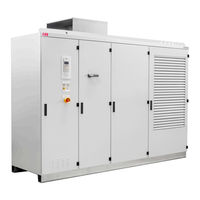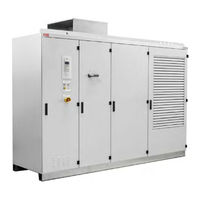ABB ACS1000 Manuals
Manuals and User Guides for ABB ACS1000. We have 3 ABB ACS1000 manuals available for free PDF download: User Manual
ABB ACS1000 User Manual (164 pages)
air-cooled
Brand: ABB
|
Category: Industrial Equipment
|
Size: 21.35 MB
Table of Contents
-
Maintenance15
-
Schematics15
-
Encoder15
-
Handling16
-
Operation16
-
Maintenance16
-
Safety Signs21
-
Overview29
-
Overview33
-
Rectifier36
-
Inverter37
-
Filter37
-
Type of Fan41
-
Overview49
-
Safety62
-
Storage68
-
Safety71
-
Cabinet Roof71
-
Safety78
-
Final Checks98
-
Overview99
-
Motor Checklist101
-
Operation102
-
Safety102
-
Overview102
-
Status Messages104
-
Emergency-Off111
-
Overview113
-
Parameters Mode122
-
Functions Mode128
-
Local Control131
-
Remote Control132
-
Logbook136
-
Spare Parts136
-
Cables and Wires137
-
Messages138
-
Fault Handling138
-
IOEC I/O Modules142
-
Safety143
-
Grounding146
-
Cover (2)161
Advertisement
ABB ACS1000 User Manual (166 pages)
SYSTEM DRIVES
Brand: ABB
|
Category: Industrial Equipment
|
Size: 14.11 MB
Table of Contents
-
Handling17
-
Operation17
-
Maintenance18
-
Overview31
-
Overview35
-
Filter38
-
Overview49
-
Safety63
-
Storage67
-
Safety69
-
Cabinet Roof69
-
Safety77
-
Final Checks102
-
Commissioning103
-
Overview103
-
Motor Checklist105
-
Operation107
-
Safety107
-
Overview107
-
Status Messages109
-
Emergency-Off116
-
Overview119
-
Parameters Mode128
-
Functions Mode134
-
Local Control136
-
Remote Control137
-
Logbook141
-
Spare Parts141
-
Cables and Wires142
-
Messages143
-
Fault Handling144
-
IOEC I/O Modules148
-
Safety149
-
Grounding152
ABB ACS1000 User Manual (186 pages)
MEDIUM VOLTAGE AC DRIVES air-cooled
Table of Contents
-
-
Overview19
-
-
Overview
32
-
-
-
-
Safety
87 -
Final Checks
107
-
08 Commissioning
110-
Overview
111
-
-
09 Operation
116-
Overview117
-
Safety117
-
Status Messages119
-
Emergency-Off127
-
-
Overview
131 -
-
Parameters Mode141
-
Functions Mode146
-
-
Local Control148
-
Remote Control149
-
-
-
-
-
Logbook156
-
Spare Parts156
-
-
Messages158
-
Fault Handling158
-
-
-
IOEC I/O Modules162
-
-
Advertisement
Advertisement


